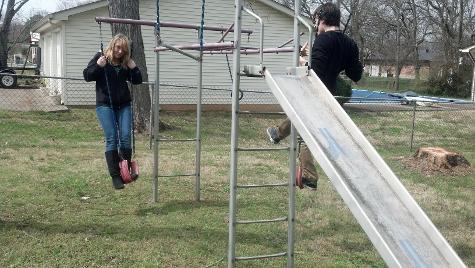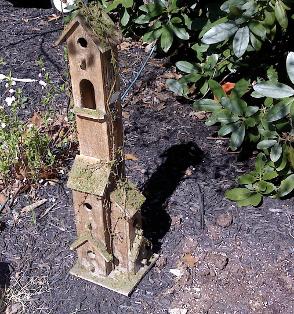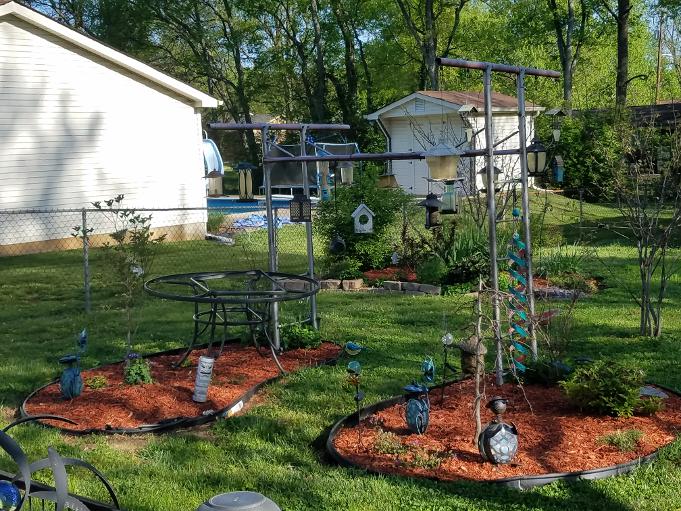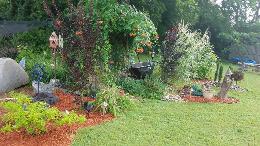This Place is For the Birds




it's for the birds and other critters
That ol' swing set would not get much use in my yard. I've no grandkids (yet). But what a perfect structure to hang things on! A little paint, remove the slide and put up the feeders. The best part is that on cold days, I can watch the birds from the comfort of my cozy den.
Coming from a family that appreciates nature, and with a Mother who believed nature belongs outside, this bird watching garden is the best of both worlds. On the nice days, sitting on the back patio, the birds pay me no mind. Sometimes they even show off a little. You can really see progress from the before and after pictures. I am planning to grow a perennial vine to make it look more natural and inviting.
It is amazing to see the wide variety of birds that visit the feeders. Use the Bird Identification Guide online or the Audubon Bird Identifier App.
In addition to the feeders, I include water features, bird houses, and plants that provide seeds that my feathered friends enjoy. Sometimes, this is simply a matter of allowing fallen seeds to germinate and grow.
 Humming birds are also frequent visitors. Their feeding station is set pretty far from the main bird garden. The feeders must be cleaned and changed at least every three days.
Humming birds are also frequent visitors. Their feeding station is set pretty far from the main bird garden. The feeders must be cleaned and changed at least every three days.
Again, I like to plant flowers that attract them and provide for some of their needs. Oh and the spiderwebs in the garden? Perfect for nesting for these tiny birds!


This is what the bird garden looks like in June of 2019. As in the movie "Field of Dreams. . . If you build it, they will come." And come they do. Chickadees, sparrows, wrens, house finches, robins, mourning doves, grackles, starlings, mocking birds, a cat bird, cow birds, purple finches, cardinals, gold finches, blue jays, a few hairy and red-capped woodpeckers and a tufted titmouse. Blackbirds and red winged blackbirds. Occasionally, a hawk visits for a quick dinner. Everyone scatters!
Blue birds too!
 A lovely pair of
A lovely pair of  blue birds nested in the yard this year. They chose the box before I had even secured it to anything! I had set it on the studio porch rail. So there it remains, but more securely attached. Both seem to take care of the nestlings. The male has several jobs. He swoops down and catches insects mid flight, bringing his catch to the nest box. He cleans out the nest. He can often be seen perched nearby, keeping a watchful eye out. He chases away unwelcome guests, diving at squirrels and other birds who happen to get to close to his home. He is spectacular to watch.
blue birds nested in the yard this year. They chose the box before I had even secured it to anything! I had set it on the studio porch rail. So there it remains, but more securely attached. Both seem to take care of the nestlings. The male has several jobs. He swoops down and catches insects mid flight, bringing his catch to the nest box. He cleans out the nest. He can often be seen perched nearby, keeping a watchful eye out. He chases away unwelcome guests, diving at squirrels and other birds who happen to get to close to his home. He is spectacular to watch.
Deeming our house/yard is a safe place, eight bird families have chosen to nest here this year. Either in a well chosen tree or shrub, or one of the many bird boxes placed in the yard.
Early spring a Robin  nested right next to the house, on a shelf used for candles and collectibles. About 5 feet from the ground, under the ledge, she chose this location to raise four young! Both parents took turns feeding them.
nested right next to the house, on a shelf used for candles and collectibles. About 5 feet from the ground, under the ledge, she chose this location to raise four young! Both parents took turns feeding them.
Not four feet away, on the opposite side of the shelf, a wren nested in a box that was placed there for  decoration! Four babies grew up and fledged within days of the robin's fledglings.
decoration! Four babies grew up and fledged within days of the robin's fledglings.
Another unusual nesting spot was under the corner of our gazebo. The netting had been bunched up and tucked up near the roof. Perfect, thought our wren. Two of the four eggs hatched and both fledged, although not on the same day. The stronger fledgling could be seen nearby fluffing his new feathers. A second fledgling was not as ready. It stayed under the gazebo for a day or two before following its parent.
Did you know that male wrens build several nests and the female chooses the one she likes! Easily attracted to a birdhouse, the male arrives first, in early Spring and begins to establish his territory. You'll know he has arrived when you begin hearing him sing from his perches. This songster will  sing from dusk to dawn mostly done during the mating season. He begins placing sticks into prospective nest holes. He may build as many as twelve different nesting sites. After pairing with a mate, the male takes the female to each of the nesting sites he has begun building.
sing from dusk to dawn mostly done during the mating season. He begins placing sticks into prospective nest holes. He may build as many as twelve different nesting sites. After pairing with a mate, the male takes the female to each of the nesting sites he has begun building.
The female selects the one she likes and begins to fill the nest completely with more twigs. Then she makes a small depression at the back of the cavity which she lines with pine needles and grass for egg laying. Interesting to note, spider egg sacs are part of the make up of nest building. It's thought that they use the spider egg sacs to help control mites in the nest. The spiders hatch and eat the mites. House wrens are cavity nesters and as such, are easily attracted to birdhouses. In fact, these birds seem to prefer man-made nest boxes to natural cavities.
The addition of the pond-less water feature (in 2019) to the bird garden has really been amazing. Birds will drink, bathe and play in the water. It seems to attract other critters as well.
Copyright All For The Garden 2025
“We are a participant in the Amazon Services LLC Associates Program, an affiliate advertising program designed to provide a means for us to earn fees by linking to Amazon.com and affiliated sites.”